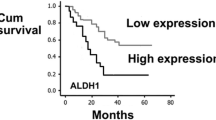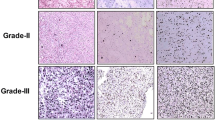Abstract
To investigate the relationship between Eg5 and histopathological grade of astrocytoma, Eg5 expression was evaluated by immunohistochemical examination on 88 specimens including 25 cases of glioblastoma (WHO grade IV), 22 cases of anaplastic astrocytoma (WHO grade III), 20 cases of diffuse astrocytoma (WHO grade II), and 21 cases of pilocytic astrocytoma (WHO grade I). The histopathological characteristics and Eg5 expression level of each tumor were assessed and statistically analyzed. Astrocytic tumors exhibited significant correlation of expression of Eg5 with higher WHO histopathological grades (p < 0.001). Eg5 is expressed in 51–98 % (mean 76.88 %) of neoplastic cells in glioblastoma, 34–57 % (mean 43.59 %) of neoplastic cells in anaplastic astrocytoma, 6–36 % (mean 18.60 %) of neoplastic cells in diffuse astrocytoma, and 2–28 % (mean 13.48 %) of neoplastic cells in pilocytic astrocytoma. In conclusion, overexpression of Eg5 associates with high-grade astrocytic neoplasm, and it may represent an independent diagnostic and prognostic factor in grading astrocytic tumors and predicting prognosis of astrocytic tumor patients.


Similar content being viewed by others
References
Sun D, Lu J, Ding K, Bi D, Niu Z, Cao Q, Zhang J, Ding S (2013) The expression of Eg5 predicts a poor outcome for patients with renal cell carcinoma. Med Oncol 30(1):476
Ding S, Xing N, Lu J, Zhang H, Nishizawa K, Liu S, Yuan X, Qin Y, Liu Y, Ogawa O, Nishiyama H (2011) Overexpression of Eg5 predicts unfavorable prognosis in non-muscle invasive bladder urothelial carcinoma. Int J Urol 18(6):432–438
Louis DN, Ohgaki H, Wiestler OD, Cavenee WK (eds) (2007) WHO classification of tumours of the central nervous system. IARC, Lyon
Kashina AS, Baskin RJ, Cole DG, Wedaman KP, Saxton WM, Scholey JM (1996) A bipolar kinesin. Nature 379:270–272
Kapitein LC, Peterman EJ, Kwok BH, Kim JH, Kapoor TM, Schmidt CF (2005) The bipolar mitotic kinesin Eg5 moves on both microtubules that it crosslinks. Nature 435:114–118
Hansen GM, Justice MJ (1999) Activation of Hex and mEg5 by retroviral insertion may contribute to mouse B-cell leukemia. Oncogene 18:6531–6539
Castillo A, Morse HC 3rd, Godfrey VL, Naeem R, Justice MJ (2007) Overexpression of Eg5 causes genomic instability and tumor formation in mice. Cancer Res 67:10138–10147
Wordeman L (2010) How kinesin motor proteins drive mitotic spindle function: lessons from molecular assays. Semin Cell Dev Biol 21:260–268
Oki E, Hisamatsu Y, Ando K, Saeki H, Kakeji Y, Maehara Y (2012) Clinical aspect and molecular mechanism of DNA aneuploidy in gastric cancers. J Gastroenterol 47:351–358
Sakowicz R, Finer JT, Beraud C, Crompton A, Lewis E, Fritsch A, Lee Y, Mak J, Moody R, Turincio R, Chabala JC, Gonzales P, Roth S, Weitman S, Wood KW (2004) Antitumor activity of a kinesin inhibitor. Cancer Res 64:3276–3280
Herrup Karl, Yang Yan (2007) Cell cycle regulation in the postmitotic neuron: oxymoron or new biology? Nat Rev Neurosci 8:368–378
Tao W, South VJ, Diehl RE, Davide JP, Sepp-Lorenzino L, Fraley ME, Arrington KL, Lobell RB (2007) An inhibitor of the kinesin spindle protein activates the intrinsic apoptotic pathway independently of p53 and de novo protein synthesis. Mol Cell Biol 27:689–698
Mayer TU, Kapoor TM, Haggarty SJ, King RW, Schreiber SL, Mitchison TJ (1999) Small molecule inhibitor of mitotic spindle bipolarity identified in a phenotype-based screen. Science 286:971–974
Liu L, Parameswaran S, Liu J, Kim S, Wojcik EJ (2011) Loop 5-directed compounds inhibit chimeric kinesin-5 motors: implications for conserved allosteric mechanisms. J Biol Chem 286(8):6201–6210
Nakai R, Iida S, Takahashi T, Tsujita T, Okamoto S, Takada C, Akasaka K, Ichikawa S, Ishida H, Kusaka H, Akinaga S, Murakata C, Honda S, Nitta M, Saya H, Yamashita Y (2009) K858, a novel inhibitor of mitotic kinesin Eg5 and antitumor agent, induces cell death in cancer cells. Cancer Res 69:3901–3909
Perez-Melero C (2014) KSP Inhibitors as antimitotic agents. Curr Top Med Chem 14(20):2286–2311
Author information
Authors and Affiliations
Corresponding author
Rights and permissions
About this article
Cite this article
Liu, L., Liu, X., Mare, M. et al. Overexpression of Eg5 correlates with high grade astrocytic neoplasm. J Neurooncol 126, 77–80 (2016). https://doi.org/10.1007/s11060-015-1954-3
Received:
Accepted:
Published:
Issue Date:
DOI: https://doi.org/10.1007/s11060-015-1954-3




